|
Tule
Ponds at Tyson
WETLANDS |
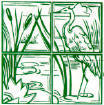 |
Self Guided tour of Tule Ponds at
Tyson Lagoon
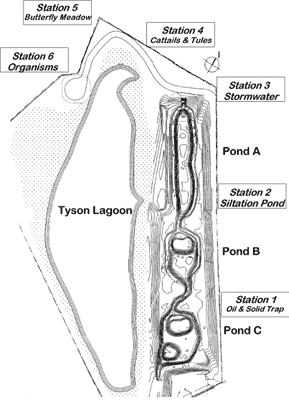 START START
The Tule Ponds at Tyson Lagoon provides a unique opportunity to see how
the needs of humans in an urban setting and other organisms can mutually
co-exist. Before humans arrived in what is now Fremont, many organisms
like mammals, birds, insects, and fish inhabited the area. As areas
become urbanized (populated with people and their buildings) the natural
order of things starts to change. Prior to urbanization, water from rain soaks into the ground and slowly
percolates into the layers of the soil and bedrock. If there were more
rain than the earth could handle, the water would “run off” causing
floods. These flood waters brought nutrients from the nearby hills, and
the plants especially benefited. As people built homes and laid down
asphalt and cement for cars to use, water flows more quickly. They
usually build homes in the flat area near a river, which is referred to
as a flood plain. The rains caused flooding and damage to many homes. To
prevent floods, engineers developed ways to allow the water to flow
quickly through man-made channels that would bring water to the San
Francisco Bay edge. It works, but it also causes valuable lost of
habitat for other creatures.
The Tule Ponds at Tyson Lagoon acts as a flood area to slow down and
contain water on its way out to the bay. After water leaves the lagoon
it flows through earth or concrete-lined channels out to the bay. This
area helps to prevent floods, but also acts as a natural place for
organisms to thrive. These wetlands also help to remove substances that enter the system from
residential, urban, and agricultural runoff. Some of these substances
are considered pollutants and may be toxic to different types of
organisms. Residential and urban runoff in this area would include
garbage, pesticides, oil and grease, organic matter, and heavy metals.
Agricultural runoff from nearby small farms would include pesticides and
nutrients. The frequency of these substances is intermittent and
dependent on winter rains.
As you walk along the trails, you will learn how water is being cleaned
before it enters the San Francisco Bay and how it is used to increase
habitat for many kinds of organisms. Stormwater enters through a large
pipe into Pond A, and then flows into Ponds B and C and then enters into
Tyson Lagoon. When the water reaches a certain level, it flows into an
outlet that parallels Mowry Ave.
Each of the 6 stations highlights a function of the entire ecosystem.
After you go through the different stations you may want to look at the
many plants and birds that can be found in this unique area.
WARNING: Please remember to keep on the trails and don’t disturb the
wildlife. Throwing rocks is not permitted and chasing wildlife is
prohibited.
STATION 1. Oil and Solid Traps
 During a storm event, water will run off from asphalt, cement, and
saturated soil Sediments, chemicals, and trash flow with the water.
Ponds B and C use logs to help retard the flow of objects that float,
like oil and garbage. Motor oil coats fish gills, preventing the fish to
use dissolved oxygen in the water. Oil can coat bird wings, making
flight difficult and prevents feathers from “fluffing up” to provide
insulation against the cold. You can notice that the constrictions
between the ponds help to narrow the flow trap these lighter objects.
The removal of harmful objects protects the wildlife. During a storm event, water will run off from asphalt, cement, and
saturated soil Sediments, chemicals, and trash flow with the water.
Ponds B and C use logs to help retard the flow of objects that float,
like oil and garbage. Motor oil coats fish gills, preventing the fish to
use dissolved oxygen in the water. Oil can coat bird wings, making
flight difficult and prevents feathers from “fluffing up” to provide
insulation against the cold. You can notice that the constrictions
between the ponds help to narrow the flow trap these lighter objects.
The removal of harmful objects protects the wildlife.
Concentrations of sediments, chemicals, and garbage change during a
storm event. The early part of a storm transports the largest amount of
larger particles whereas the later stages of storms have a higher
percentage of dissolved hydrocarbons and dissolved metals. The velocity
of the water also slows as stormwater enters the Tule Pond system. This
allows heavy particles to drop out of the system first.
STATION 2. Siltation Pond
 Pond A is designed to slow the flow of water to allow suspended
particles to drop out of the water column. This increases the water
quality of the water so it is less of a potential hazard when it enters
the San Francisco Bay. The suspended particles range from heavy metals,
such as copper (Cu), lead (Pb) and zinc (Zn), to simple particles like
sediment and soil. The particles increase turbidity and prevent the
penetration of sunlight to phytoplankton. Increased nutrients from
fertilizers (such as nitrogen (N), phosphorus (P), and Potassium (K)
create algal “blooms.” As the plants decompose they cause conditions
unfriendly to organisms in the water (eutrophication). Lead comes from
paints, wood staining products, and emissions from diesel and gasoline
operated vehicles. Zinc is from automobile tires, paints, and wood
staining products. Copper comes from plumbing, electroplating processing
wasters, brake pads in automobiles, and algaecides. In high dosages
these substances can be hazardous to organisms that live or frequent the
ponds. Pond A is designed to slow the flow of water to allow suspended
particles to drop out of the water column. This increases the water
quality of the water so it is less of a potential hazard when it enters
the San Francisco Bay. The suspended particles range from heavy metals,
such as copper (Cu), lead (Pb) and zinc (Zn), to simple particles like
sediment and soil. The particles increase turbidity and prevent the
penetration of sunlight to phytoplankton. Increased nutrients from
fertilizers (such as nitrogen (N), phosphorus (P), and Potassium (K)
create algal “blooms.” As the plants decompose they cause conditions
unfriendly to organisms in the water (eutrophication). Lead comes from
paints, wood staining products, and emissions from diesel and gasoline
operated vehicles. Zinc is from automobile tires, paints, and wood
staining products. Copper comes from plumbing, electroplating processing
wasters, brake pads in automobiles, and algaecides. In high dosages
these substances can be hazardous to organisms that live or frequent the
ponds.
STATON 3. Stormwater Inflow
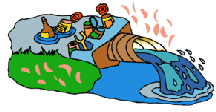 Residential and urban growth in a watershed increases water runoff. When
you construct a home, industry or road, water is then prevented from
percolating downwards into the ground and flows into a series of
connecting pipes. If you look at the beginning of Pond A you will see a
large pipe. Water in this pipe comes from a series of storm drains
connected by underground pipes. Residential and urban growth in a watershed increases water runoff. When
you construct a home, industry or road, water is then prevented from
percolating downwards into the ground and flows into a series of
connecting pipes. If you look at the beginning of Pond A you will see a
large pipe. Water in this pipe comes from a series of storm drains
connected by underground pipes.
Water seeks sea level, so drainage in a watershed is determined by
topography. Drainage in the Tule Pond is restricted to a watershed that
includes the surrounding area. Runoff occurs when the zone of aeration
(where plants take up water) is saturated and when excess water cannot
percolate into the ground. Runoff contains suspended particles such as
silt as well as dissolved substances. Some of the particles are natural,
from erosion caused by weathering of the nearby hills. However some
substances are added by humans, including heavy metals, garbage, and
dissolved chemicals.
STATION 4. Cattails and Tules
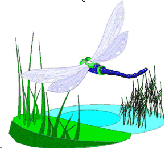 Water quality is frequently enhanced as water passes through wetland.
Plants help to slow the flow of surface run off and cause sediment to
settle out. Living aquatic plants like algae and large emergent plants
like tules and cattails, add dissolved oxygen to water during
photosynthesis. Wetland plants support much of the life in open water,
and plants like cattails and tules provide shelter for larger animals
living in the pond. Water quality is frequently enhanced as water passes through wetland.
Plants help to slow the flow of surface run off and cause sediment to
settle out. Living aquatic plants like algae and large emergent plants
like tules and cattails, add dissolved oxygen to water during
photosynthesis. Wetland plants support much of the life in open water,
and plants like cattails and tules provide shelter for larger animals
living in the pond. Wetlands have characteristic vegetation that can tolerate being
submerged in water. Wetland plants do not require an elaborate way of
capturing water like trees. Certain plants in these vegetated waterways
are effective in removing metals from storm water. Metals accumulate
near outflow and are not transported very far downstream. Zinc is an
exception because it stays in dissolved form.
STATION 5. Butterfly Meadow
 Butterflies are indicators of the overall health of an ecosystem. Loss
of habitat is a major threat to butterflies as open meadows turn into
residential areas. Butterflies are beautiful but are important
pollinators of many plants. They also provide a food source for many
birds, mammals, reptiles and even other insects. Butterflies are indicators of the overall health of an ecosystem. Loss
of habitat is a major threat to butterflies as open meadows turn into
residential areas. Butterflies are beautiful but are important
pollinators of many plants. They also provide a food source for many
birds, mammals, reptiles and even other insects.
This butterfly meadow will not only help repopulate native butterflies
but will be a home of many native plants that serve as a food source for
the caterpillars that will change into a chrysalis before the butterfly
emerges. The nectar can be also used by other animals like hummingbirds.
STATION 6.Organisms of Tyson Lagoon
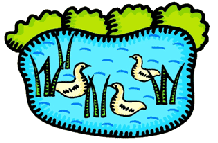 Wetlands are among the most productive ecosystems in the world. A fresh
water marsh is as productive as a tropical rain forest. Wetland plants
are specialized because they can withstand water levels that most land
plants cannot. Bacteria, protozoa, and fungi are bountiful as
decomposition of organic matter releases nutrients. These microscopic
critters are eaten by larger invertebrates like arthropods and mollusks,
that in turn are eaten by amphibians, reptiles and fish. Wetlands are among the most productive ecosystems in the world. A fresh
water marsh is as productive as a tropical rain forest. Wetland plants
are specialized because they can withstand water levels that most land
plants cannot. Bacteria, protozoa, and fungi are bountiful as
decomposition of organic matter releases nutrients. These microscopic
critters are eaten by larger invertebrates like arthropods and mollusks,
that in turn are eaten by amphibians, reptiles and fish.
The top of the food web includes birds and mammals. Tyson Lagoon is
resident to many birds who find this area a haven. Many build their
nests here and feast on the abundant food source throughout the year.
|